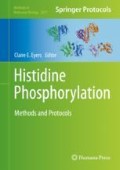Abstract
Liquid chromatography (LC)-tandem mass spectrometry (MS/MS) is key for the characterization of phosphorylation sites in a high-throughput manner, and its application has proven essential to elucidate the phosphoproteome of many biological systems. Following proteolytic digestion of proteins extracted from tissues or cells, phosphopeptides are typically enriched by affinity chromatography using TiO2 or metal-ions (e.g., Fe3+) coupled to solid-phase materials, prior to LC-MS/MS analysis. Separation of relatively low abundance phosphopeptides from nonphosphorylated peptides in these types of extremely complex mixtures is essential to maximize coverage of the phosphoproteome. Maintaining acidic conditions during these IMAC or TiO2-based enrichment minimizes the concurrent unwanted binding of highly acidic peptides. However, while peptides containing phosphomonoesters, namely, phosphoserine (pSer), phosphothreonine (pThr), and phosphotyrosine (pTyr), are stable under these acidic binding conditions, phosphopeptides containing acid-labile phosphate group such as phosphohistidine (pHis), are not. Consequently, hydrolysis of these types of phosphopeptides occurs during standard phosphopeptide enrichment, and subsequent phosphosite identification by LC-MS/MS is severely compromised. Here we describe UPAX, unbiased phosphopeptide enrichment using strong anion exchange, for the separation of both acid-stable (pSer, pThr, pTyr) and acid-labile phosphopeptides (including those containing pHis) from nonphosphorylated peptides. We outline how implementation of UPAX prior to a minimally modified standard proteomics workflow can be used to identify sites of pHis as well as other acid-labile, as well as acid-stable phosphosites.
Access this chapter
Tax calculation will be finalised at checkout
Purchases are for personal use only
References
Attwood PV, Piggott MJ, Zu XL et al (2007) Focus on phosphohistidine. Amino Acids 32:145–156
Hultquist DE, Moyer RW, Boyer PD (1966) The preparation and characterization of 1-phosphohistidine and 3-phosphohistidine. Biochemistry 5:322–331
Hultquist DE (1968) The preparation and characterization of phosphorylated derivatives of histidine. Biochim Biophys Acta 153:329–340
Dai J, Jin WH, Sheng QH et al (2007) Protein phosphorylation and expression profiling by Yin-yang multidimensional liquid chromatography (Yin-yang MDLC) mass spectrometry. J Proteome Res 6:250–262
Nie S, Dai J, Ning ZB et al (2010) Comprehensive profiling of phosphopeptides based on anion exchange followed by flow-through enrichment with titanium dioxide (AFET). J Proteome Res 9:4585–4594
Alpert AJ, Hudecz O, Mechtler K (2015) Anion-exchange chromatography of phosphopeptides: weak anion exchange versus strong anion exchange and anion-exchange chromatography versus electrostatic repulsion-hydrophilic interaction chromatography. Anal Chem 87:4704–4711
Han G, Ye M, Zhou H et al (2008) Large-scale phosphoproteome analysis of human liver tissue by enrichment and fractionation of phosphopeptides with strong anion exchange chromatography. Proteomics 8:1346–1361
Hardman G, Perkins S, Ruan Z et al (2017) Extensive non-canonical phosphorylation in human cells revealed using strong-anion exchange-mediated phosphoproteomics. bioRxiv 2017:202820
Hardman G, Perkins S, Brownridge PJ, Clarke CJ, Byrne DP, Campbell AE, Kalyuzhnyy A, Myall A, Eyers PA, Jones AR, Eyers CE, (2019) Strong anion exchange‐mediated phosphoproteomics reveals extensive human non‐canonical phosphorylation. The EMBO Journal 21:e100847. doi:10.15252/embj.2018100847
Ferries S, Perkins S, Brownridge PJ et al (2017) Evaluation of parameters for confident phosphorylation site localization using an orbitrap fusion tribrid mass spectrometer. J Proteome Res 16:3448–3459
Rappsilber J, Mann M, Ishihama Y (2007) Protocol for micro-purification, enrichment, pre-fractionation and storage of peptides for proteomics using StageTips. Nat Protoc 2:1896–1906
Perkins DN, Pappin DJ, Creasy DM et al (1999) Probability-based protein identification by searching sequence databases using mass spectrometry data. Electrophoresis 20:3551–3567
Taus T, Kocher T, Pichler P et al (2011) Universal and confident phosphorylation site localization using phosphoRS. J Proteome Res 10:5354–5362
Acknowledgments
This work was supported by the Biotechnology and Biological Sciences Research Council (BBSRC) in the form of DTP funding to G.H. and grants to C.E. (BB/M012557/1, BB/R000182/1, BB/H007113/1), and the North West Cancer Research Fund (NWCR) (CR1157). We thank all members of the Centre for Proteome Research, particularly Dr. Philip Brownridge, for continued support.
Author information
Authors and Affiliations
Corresponding author
Editor information
Editors and Affiliations
Rights and permissions
Copyright information
© 2020 Springer Science+Business Media, LLC, part of Springer Nature
About this protocol
Cite this protocol
Hardman, G., Eyers, C.E. (2020). High-Throughput Characterization of Histidine Phosphorylation Sites Using UPAX and Tandem Mass Spectrometry. In: Eyers, C. (eds) Histidine Phosphorylation. Methods in Molecular Biology, vol 2077. Humana, New York, NY. https://doi.org/10.1007/978-1-4939-9884-5_15
Download citation
DOI: https://doi.org/10.1007/978-1-4939-9884-5_15
Published:
Publisher Name: Humana, New York, NY
Print ISBN: 978-1-4939-9883-8
Online ISBN: 978-1-4939-9884-5
eBook Packages: Springer Protocols

